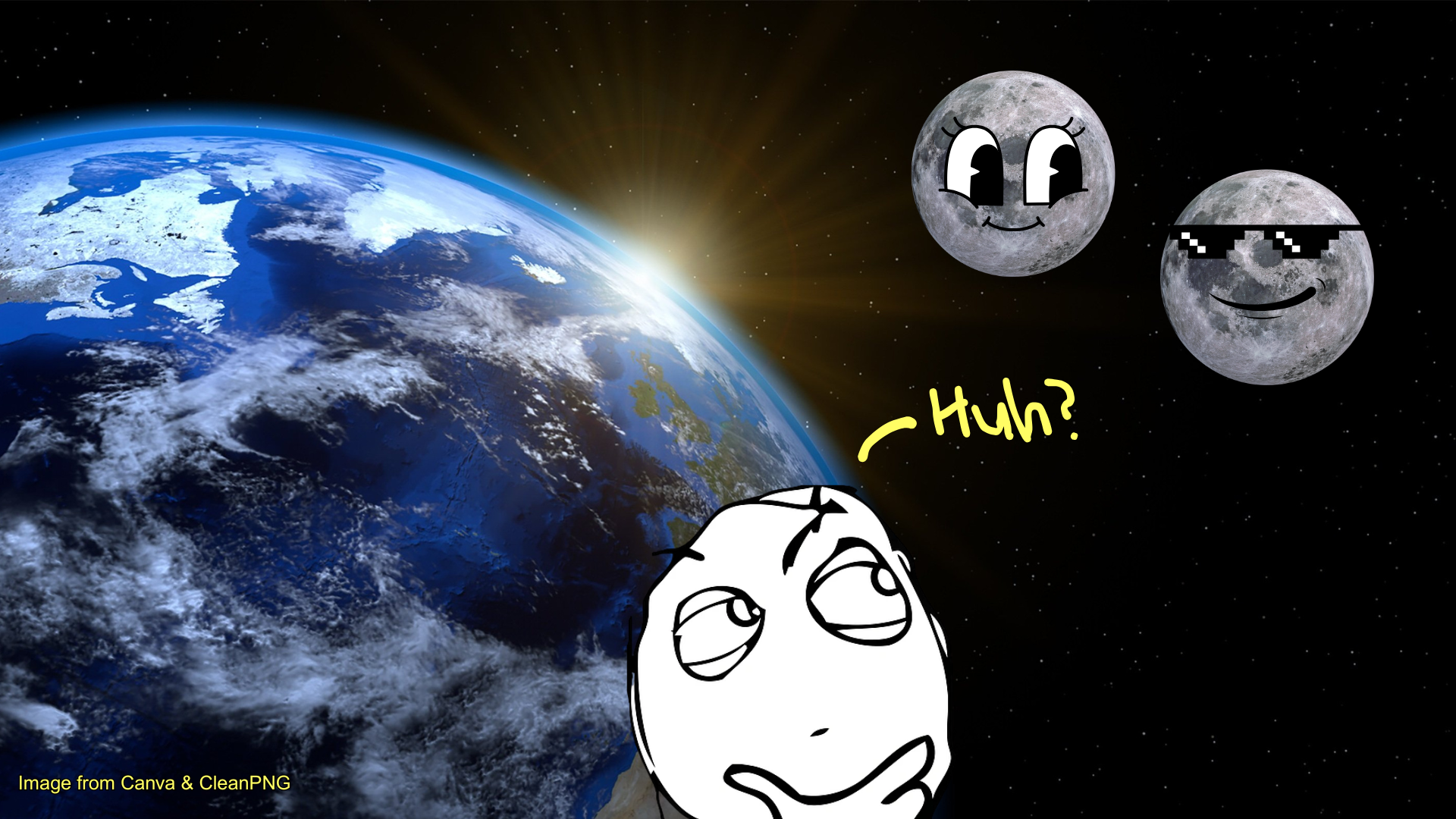Earth got 2 moons? Bet you didn’t know these 6 other things about space
2 days ago
Y’all got wonder or not, whenever you look up at the star studded sky and the moon, what else might be up there? If you haven’t, it’s time you did. The night sky hides more mysteries than you might think. ⭐
These days, it’s not just scientists blasting off into space anymore, it’s also pop stars, journalists, and billionaires’ fiancées. In April 2025, Blue Origin (the company owned by Amazon’s Jeff Bezos) launched its NS-31mission with six civilians, including none other than Katy Perry and Jeff Bezo’s now wife, Lauren Sánchez.
Naturally, the internet lost its collective mind partly because of how flashy the whole thing was, and partly because… well, it was just kinda very cringe TT.
Whether you see it as a historic feminist milestone or a billionaire’s pricey PR stunt (or both?), it definitely proves one thing: space is no longer just for astronauts in boring white suits. It’s become entertainment, a spectacle, even meme material. And beneath all that glitz, our curiosity about space is still very real.
If pop stars can float past the Kármán line, imagine what else is out there just waiting to be discovered. So in honour of Asteroid Day, we decided to shoot for the stars and list down 7 mind-blowing things humans have discovered about the universe.
1. Earth actually has two moonsDid y’all know Earth technically has two moons? Yes, TWO. Besides our usual big, bright moon that shows up in poems and puasa calendars, scientists found another object orbiting Earth: a lil’ asteroid called 2016 HO3.
Ok, technically it’s not an official second moon because unlike the actual moon, this asteroid actually orbits the sun. But because it kinda loops around Earth too, scientists refer to 2016 HO3 as Earth’s “quasi-satellite”.
NASA says it’s somewhere between 120 to 300 feet wide and it’s been tagging along with us for at least a hundred years. And that it will probably keep doing so for centuries. Eeee what a clingy bestie.
2. Humans are expected to explore Mars by 2030The existence of planet Mars has been known since 400BC by Babylonians who call it Nergal, after their god of war, pestilence, and death. At the time, all they saw was a bright red star that would sometimes move weirdly.
When the telescope was invented around the 1600s, it opened up a whole new way of looking at the sky. People were observing stuff left, right and centre. By the 1880s, astronomy had come far enough that scientists could spot craters on Mars, which got people speculating about aliens living there.
This speculation ran so deep that in 1938, when Orson Welles pulled a prank about Earth being invaded by aliens from Mars in a radio adaptation of H.G Wells’s “The War of the Worlds”, some Americans actually panicked. Altho to be fair, some historians now say the so called “mass hysteria” might have been overhyped by newspapers who wanted to make radio look bad.
The plan to explore Mars got more serious when satellites were sent out to snap photos of its surface. This exploration reached its peak when NASA successfully landed two exploration rovers named Spirit and Opportunity. These two fellas sent back over 100,000 high-res photos of Mars’s surface, rocks, and soil, helping scientists confirm that the planet did have water once before it dried up into the dusty red ball it is today.
Spirit completed one full Martian year (which is about 687 Earth days) on November 20, 2005. Sadly, lil Spirit’s mission ended in 2010 after getting stuck in a sand dune. Meanwhile, its twin rover Opportunity kept going and, by 2015, had traveled nearly 43 kilometers on Mars.
If you wanna know more about the Mars missions, especially what Spirit and Opportunity were doing apart from taking selfies, you can watch this video.
NASA’s also planning to send humans to Mars by 2030, and they’ve broken the mission into three phases.
And while NASA might be leading the charge to Mars, they’re not the only ones who’ve tried. One of the more ambitious efforts came from a company called Mars One and if you try looking up their official website now, you’ll be met with the sweet silence of a domain that no longer exists.
Back when they were still around, Mars One made headlines for their bold plan to send humans to Mars by 2031. The craziest part is literally anyone could apply. As in any random Mamat could just send in their application, go through training, and they could be part of the mission. Unfortunately, things didn’t quite take off (literally and financially), and by 2019, a Swiss court declared them bankrupt. So… yeah.
Meanwhile, scientists are still running psychological experiments to figure out how humans would actually cope with living on Mars. Which, honestly, sounds like something worth figuring out before sending people 225 million km away ????.
3. We landed on a comet in 2014! ☄️Comets have always been wrapped in myth and mystery, from being omens of doom to planet crushing missiles. While most of us grew up hearing that an asteroid destroyed the dinosaurs, some scientists believe it might have actually been a comet (or a piece of one) that slammed into the Earth 65 million years ago, wiping out nearly 70% of all life!
But what are comets really? Well in simple terms, they’re clumps of frozen gas, stones, and dust roughly the size of a small town. Scientists think comets have been around since the early days of the solar system, which means studying them could tell us more about where we all came from.
In 1993, the European Science Agency approved the International Rosetta Mission. From that point on, teams of scientists worked together to figure out how to orbit and land on one of these icy spaceballs.
After launching in 2004, the Rosetta spacecraft spent a decade cruising through space. It flew past two comets in 2008 and 2010, but didn’t stop. Then finally, in 2014, it caught up with a comet named 67P/Churyumov–Gerasimenko (y’all try saying that three times fast). Rosetta followed it closely, and in November, sent down a little probe called Philae to land on its surface.
Philae only managed to transmit data for three days before its battery died but in that short time, it collected enough info to change how we see the universe. Scientists found organic compounds on the comet, giving us even more reason to believe that we might not be alone out here after all.
4. Pluto is not a “true” planetRemember in school when we were learning about the solar system? Our teachers introduced 9 planets that orbit the sun, and Pluto was one of them. Humans discovered Pluto in 1930, but in 2006, Pluto got its planet status revoked.
Why, you ask? Well, that year, the International Astronomical Union (IAU) redefined the meaning of the word planet, and poor Pluto didn’t pass one of the key criteria. Namely, it doesn’t clear its orbit of space junk.
To be a real planet, your gravity needs to be strong enough to either pull in, crash into, or fling away other stuff that’s hanging around in your orbit. Now, not only is Pluto not yeeting these other stuff away, it’s in fact sharing its orbit with bigger objects in a region called the Kuiper Belt.
So long story short, Pluto got demoted to a dwarf planet. Kwang kwang kwang.
As expected, not everyone took the news well. Plenty of scientists and heartbroken 90s kids protested the decision, hoping for a redemption arc. But as of now, Pluto’s still stuck in dwarf planet limbo, and our solar system officially has only eight planets.
5. Radio waves were detected in space. Aliens…dat you? ????In 2001, scientists detected radio waves for 5 milliseconds from a galaxy that is billions of light years away from Earth. No one really thought much of it, until 2007 when the sound was much clearer, but scientists had no way of explaining this wave.
The only thing they knew was that the energy radiating off this wave was 500 times stronger than the energy radiating off of the Sun. Since then, these mysterious bursts coming from way beyond our Milky Way have been called fast radio bursts (FRBs).
Fast forward to now and over a thousand FRBs have been spotted but we only know where about a hundred of them come from. The first FRB, FRB 121102, was discovered in a dwarf galaxy about 3 billion light years away from Earth. The record holder for the most distant FRB is FRB 20230521B, which is a whopping 9.1 billion light years away.
Scientists have a bunch of theories about what’s causing FRB 121102. Some say it could be the explosion of a star going supernova, others think it might come from super-magnetic neutron stars called magnetars. There’s also the idea that it’s the signal made when stars collapse into black holes. We gotta say tho, the juiciest theory by far is that these signals could be aliens trying to reach out to us.
If you think you have a better grasp of alien language, here’s where you can check out how FRB 121102 sounds like.
Humans have actually been sending radio signals into space since 1974, but our broadcasts can only travel about 200 light years. It sounds impressive until you realise the universe is basically infinite. So if these FRBs really are coming from aliens, their tech isn’t just better, it’s on a whole other level of intergalactic Wi-Fi.
For now tho, there is not much we know about FRBs so we’ll just have to wait and see.
6. After 100 years, we can finally prove Einstein was rightAlbert Einstein was arguably one of the most brilliant minds in human history and spent his life doing maths most of us would rather not look at. But in 1915, he dropped something that literally changed how we understand the universe: the theory of general relativity.
Basically, Einstein said that massive objects (like stars or planets) can bend space and time around them and that’s what we experience as gravity. For those of you who never once paid attention in Physics, think of it like putting a bowling ball on a mattress. So the heavier it is, the more it sinks and pulls stuff toward it.
He even predicted that when massive things collide, they send out little ripples in space-time called gravitational waves. John Wheeler, an American physicist, also used Einstein’s theory to propose the concept of black holes. But here’s the thing, back then, we didn’t have the tech to actually detect those waves. So for decades, his theory just sat there like a little mathematical doodle.
Then September 14 2015, exactly a century later, scientists finally detected an irl gravitational wave, caused by a black hole collision that happened 1.3 billion years ago. The best part is one of the scientists involved in the discovery was a Malaysian, Hafizah Noor Isa, who was doing her PhD at the University of Glasgow at the time.
And that’s not all. In 2017, another Malaysian, Nur Adlyka Ainul Annuar, a PhD student at Durham University, helped confirm the existence of a black hole located 38 million light years away.
7. Got extra money ah? Bougee-fy your holiday plans to…the moon! ????If you’ve somehow managed to live your life without knowing who Elon Musk is, honestly, we envy your peace.
But for the rest of us, he’s the guy behind a long list of ventures, from electric cars to exploding Twitter – sorry, X – and of course, SpaceX, his private space company that quite literally sends people (and satellites) out of this world. Even NASA sometimes tumpang his rockets to send astronauts to the ISS.
Back in 2017, Elon proudly announced that two private citizens had paid a massive deposit for a trip around the Moon. One of them later turned out to be Japanese billionaire and founder of Japanese e-commerce giant Zozo, Yusaku Maezawa, who also said he’d be bringing six to eight artists of his choice along for the ride.
The journey was supposed to cover about 300,000 to 400,000 miles, making it the first human mission near the Moon in over 45 years. It was called the dearMoon project and was originally scheduled for 2018… then postponed to 2023… and finally, in 2024, Maezawa himself quietly cancelled it due to constant technical delays.
Still, if they ever get this project off the ground (hah), it will totally revolutionize what we know about space tourism.
But to be fair, Elon and Maezawa weren’t the first to splurge on a ticket to the stars. That title goes to Dennis Tito, the world’s first ever space tourist who dropped USD 20 million back in 2001 to hitchhike with the Russians to the ISS.
It’s so weird to think that we’re just a speck in this massive universeEven with all the satellites, telescopes, and PhDs in the world, there’s still a galaxy’s worth of stuff we don’t understand. Some people might roll their eyes and say astronomy feels a bit too out there, like why bother looking up when there’s already enough drama down here?
But with the way things are going lately with floods, wildfires, earthquakes, tsunamis, and our resources slowly drying up, maybe it’s not that far-fetched to start thinking about Plan B. Cos if space teaches us anything, it’s how small we are… and how much bigger we could be.
But until the day rockets are as common as RapidKL busses and we’re booking Airbnbs on Mars, this little blue marble is still the only home we’ve got. Now go hug a tree or recycle something ????????????.
...Read the fullstory
It's better on the More. News app
✅ It’s fast
✅ It’s easy to use
✅ It’s free









